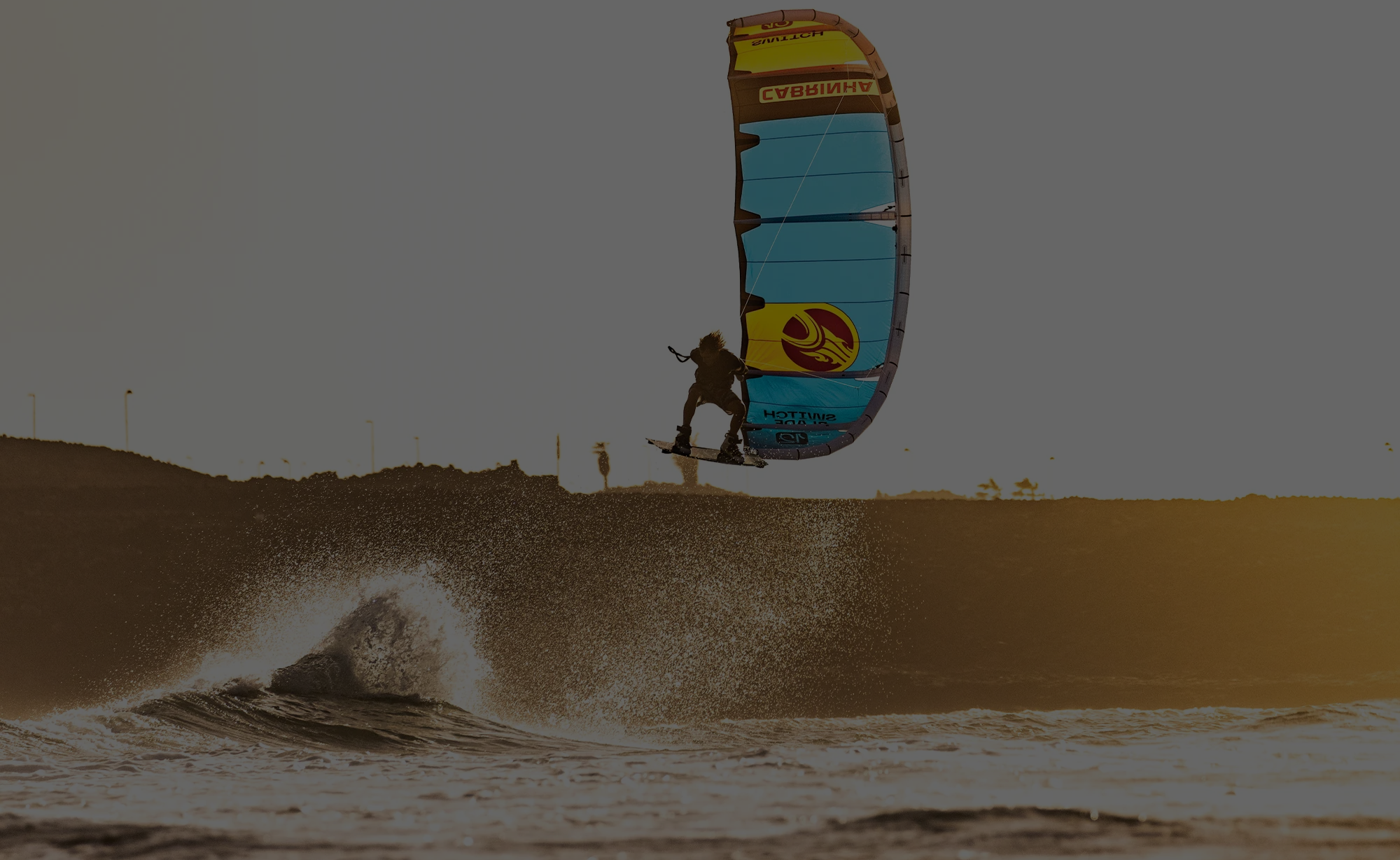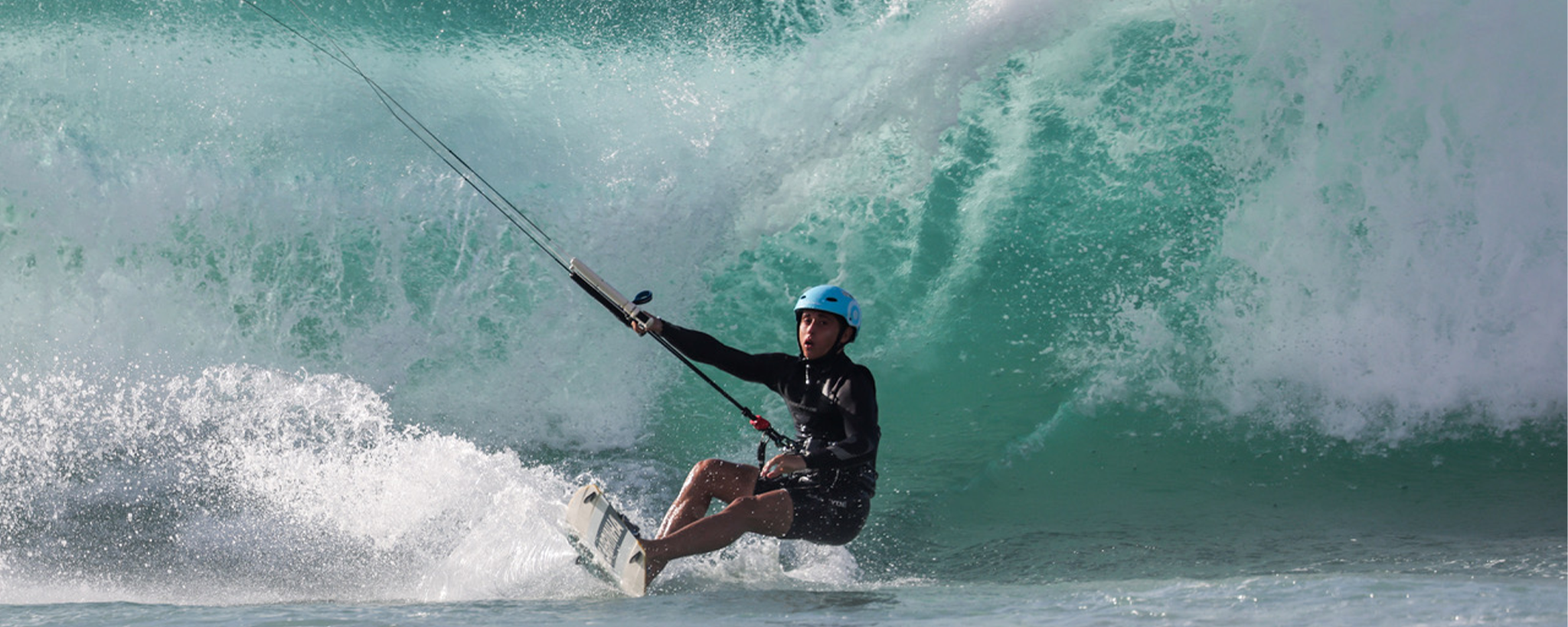Article: 7 Essential Kitesurfing Safety Tips for Beginners

7 Essential Kitesurfing Safety Tips for Beginners
Kitesurfing is thrilling but comes with risks. To stay safe, follow these 7 key kitesurfing safety tips for beginners :
-
Choose the Right Gear : Wear a helmet , impact vest, and make sure to use a fully functions control system with quick release as well as a safety leash connected to the kites de-power line. Always inspect your equipment before every session.
-
Understand Weather Conditions : Stick to steady winds (12–25 knots) when starting out and avoid gusty or offshore winds. Flat water also offers more favourable learning conditions
-
Learn how to Self-Rescue : Practice depowering your kite, securing the lines, and performing a deep water pack down. Any kite school will teach this as part of beginner lessons
-
Avoid Common Mistakes : Keep a safe distance to shore, ride within your skill level, and always try and practice in suitable conditions.
-
Get Assistance : Launch and land your kite with help, and always kitesurf with a buddy. Kitesurfers are usually always happy to launch and land as it is a fundamental part of the sport and staying safe
-
Stay Alert : Monitor changing conditions and be prepared to stop if necessary. Weather fronts can come in quickly and lead to changing wind speeds
-
Join a Community : Learn from experienced riders and stay updated on safety practices.
Quick Tip : Safety is your foundation for enjoying kitesurfing. Equip yourself, stay aware, and practice regularly to build confidence on the water.
Table of content
1. Choose the Right Safety Gear
The right safety equipment is crucial when you're kitesurfing. It’s the first step in protecting yourself from potential accidents.
- Wear a Helmet and Impact Vest
A well-fitted helmet is a must. It protects your head from impacts with the water, your board, or other objects, helping to prevent serious injuries. Look for a helmet that’s snug, comfortable, and meets safety standards.
Impact vests do double duty - they provide flotation and shield your vital organs during crashes. Make sure your vest fits securely without limiting your movement. You’ll want enough flexibility for swimming and a design with secure straps or fasteners.
A quick-release system can make all the difference in an emergency. This system allows you to quickly depower your kite, keeping you from losing control or being dragged underwater. Modern systems are designed to be easy to use, even in high-pressure situations.
- Use a Leash and Quick-Release System
Kite leashes are essential, but board leashes can be risky, especially for beginners, as they might cause snapback injuries. If you’re new to kitesurfing, focus on mastering body dragging techniques to retrieve your board safely.
Before every session, inspect your gear to ensure everything is in good condition:
|
Equipment Part |
What to Check |
|
Quick-Release |
Ensure it operates smoothly and shows no signs of corrosion or staying shut |
|
Lines |
Look for any wear or weak spots on your lines. It's also important to make sure your lines are equal lengths. |
|
Helmet |
Check for cracks or loose straps |
|
Impact Vest |
Confirm buoyancy and check straps or zippers for damage |
Check out this step-by-step guide from, where Phil walks you through the essentials of tuning your Control System to keep your setup in peak condition :
With your safety gear ready, the next step is to familiarize yourself with weather conditions to ensure a safe kitesurfing experience.
2. Learn to Read Weather Conditions
Knowing how to interpret weather conditions is a key safety skill for kitesurfing. It can make the difference between a fun day on the water and a potentially dangerous situation.
- Check Wind Strength and Direction
For beginners, aim for steady winds between 12-25 knots. Avoid offshore winds, which can pull you out to sea, or directly onshore winds that could push you onto land. Side-shore winds are ideal, as they keep you parallel to the beach, giving you better control as you practice.
- Steer Clear of Gusty or Unstable Weather
In gusty conditions, your kite can behave unpredictably, making it harder to control. Look out for warning signs like dark clouds, sudden wind shifts, or unusual wave activity. Always check a reliable, location-specific weather forecast before heading out.
If the weather looks questionable, it's better to pack up early. While on the water, stay alert - conditions can change quickly.
Being able to read the weather not only keeps you safer but also boosts your confidence on the water. Once you’ve got this skill down, you’re ready to move on to learning basic self-rescue techniques.
3. Practice Basic Self-Rescue Skills
Knowing how to rescue yourself on the water is a must-have skill for any kiteboarder. These techniques can help you stay safe and handle surprises with more confidence.
4. Avoid Beginner Mistakes
Mistakes are part of learning, but in kitesurfing, some can be risky. Knowing and steering clear of common beginner errors can help you stay safe while enjoying the sport.
- Keep a Safe Distance
Always maintain enough space between yourself and others - whether they're riders, swimmers, or obstacles. This reduces the chance of collisions. Plan your course early and stick to local guidelines for minimum distances. If the area feels too crowded, find a quieter spot or wait for better conditions.
- Stay Within Your Skill Level
Be honest about your abilities and avoid taking on challenges that are beyond your current level. Trying to progress too quickly can lead to mistakes and unnecessary risks.
Here’s a quick guide to help you practice safely:
|
Skill Level |
Suitable Conditions |
Focus Areas |
|
Beginner |
Light winds (10-18 knots) |
Basic steering, body dragging, water starts |
|
Intermediate |
Moderate winds (12-20 knots) |
Upwind riding, basic transitions |
Work on mastering the fundamentals before moving on to advanced skills. Make sure you can consistently control your kite and ride steadily before trying new tricks. When experimenting with new techniques, choose lighter wind conditions to minimize risks.
5. Follow Extra Safety Tips
Staying safe while kitesurfing isn't just about personal precautions - it also involves teamwork and having the right support.
- Launch and Land with Assistance
Launching and landing your kite are moments that demand extra care. These steps can be safer with the help of someone experienced. When launching, ask another kiteboarder for a lunch, make sure the area is clear, and check the tension of your lines, making sure there are no tangles. When ready give a thumbs up and you can slowly move the kite u in the wind window.
For landing, notify your helper in advance, reduce the kite’s power, and avoid crowded spots. Having someone skilled to assist during these high-risk moments can greatly lower potential dangers.
- Kitesurf with a Partner
Conclusion
By following these safety practices, you can minimize risks and make the most out of your kitesurfing experience. Statistics show that many kitesurfing accidents can be prevented with the right equipment and adherence to safety guidelines. Staying equipped and aware of weather conditions is key to building confidence and advancing in the sport.
Think of safety as the foundation for freedom on the water. By staying committed to safety, practicing consistently, and connecting with experienced riders, you'll grow in the sport while respecting its challenges. This mindset not only ensures your well-being but also helps you enjoy kitesurfing for years to come.
Frequently Asked Questions
1. What is the best kite for beginners?
Cabrinha offers several beginner-friendly kites, such as the Switchblade & Moto X, both known for stability, ease of use, and forgiving design. These kites are ideal for those learning kiteboarding because they offer smooth power delivery and excellent relaunch capabilities. Explore beginner kites in the Cabrinha Kites collection .
2. How do I choose the right kite for my weight and skill level?
Your kite choice depends on factors such as:
• Weight: Heavier riders may need larger kites for more power.
• Skill Level: Beginners should opt for kites that are stable and easy to control, like the Moto X or Switchblade.
• Wind Conditions: Choose the appropriate kite size based on the average wind speeds in your location. Cabrinha offers a kite size chart to help you decide.
3. What is the difference between freestyle and wave kites?
Freestyle kites, like the FX2, are designed for tricks, jumps, and unhooked riding, offering quick turns and explosive power. Wave kites, such as the Drifter, excel in surf conditions with excellent drift and control in onshore and offshore winds. Check out Cabrinha’s specialized kites for freestyle and wave riding .
4. Which Cabrinha kite is best for light wind conditions?
For light wind conditions, the Contra series is an excellent choice. It’s specifically designed to perform well in low wind with exceptional efficiency and power generation. Perfect for maximizing your time on the water when the breeze is light.









